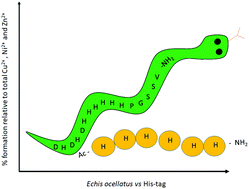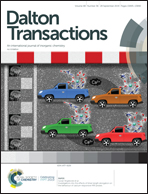Uncapping the N-terminus of a ubiquitous His-tag peptide enhances its Cu2+ binding affinity†
Abstract
Metal complexes with an N-terminally free and N-terminally acetylated polyhistidine region of Echis ocellatus venom, with an interesting His-rich motif present in numerous metal binding proteins from all kingdoms of life (DHDHDHHHHHHPGSSV-NH2 and Ac-DHDHDHHHHHHPGSSV-NH2) show the role of the free amino group in the thermodynamic enhancement of Cu2+, Ni2+ and Zn2+ binding. In the studied sequences, Cu2+ can be coordinated by different sets of imidazole rings, and a 3–10 helix is detected in close proximity of Cu2+ binding sites. The complexes are more stable than those with a typical His6-tag, despite a similar copper(II) coordination mode in both cases.



 Please wait while we load your content...
Please wait while we load your content...